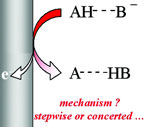Publication
675
Chem. Rev.
110 (12),
PR1– PR40, 2010.
DOI: 10.1021/cr100038y
|
|
|
|
|
|
 |
Update 1 of: Electrochemical Approach to the Mechanistic Study of Proton-Coupled Electron Transfers |
|
|
|
|
|
|
|
Cyrille Costentin, Marc Robert, and Jean-Michel Savéant
Laboratoire d’Electrochimie Moléculaire, Unité Mixte de Recherche Université, CNRS No. 7591, Université Paris Diderot, 15 rue Jean de Baïf, 75013 Paris, Francee
This is a Chemical Reviews Perennial Review. The root paper of this title was published in Chem. Rev. 2008, 108 (7), 2145-2179, DOI: 10.1021/ cr068065t
Introduction
(1st paragraph)
The coupling between electron and proton transfers has a long experimental and theoretical history in chemistry and biochemistry. To take just one example, the fact that acceptance of an electron triggers the addition of an acid or the removal of a base and vice versa for oxidations towers over all understanding of organic electrochemistry. Protoncoupled electron transfer (PCET) reactions also play a critical role in a wide range of biological processes, including enzyme reactions, photosynthesis, and respiration as well as in the activation of small molecules involved in conversion and storage of solar energy, mainly water oxidation and proton and carbon dioxide reduction. Several recent reviews describe PCET reactions and phenomena PCET is employed here as a general term for reactions. |

